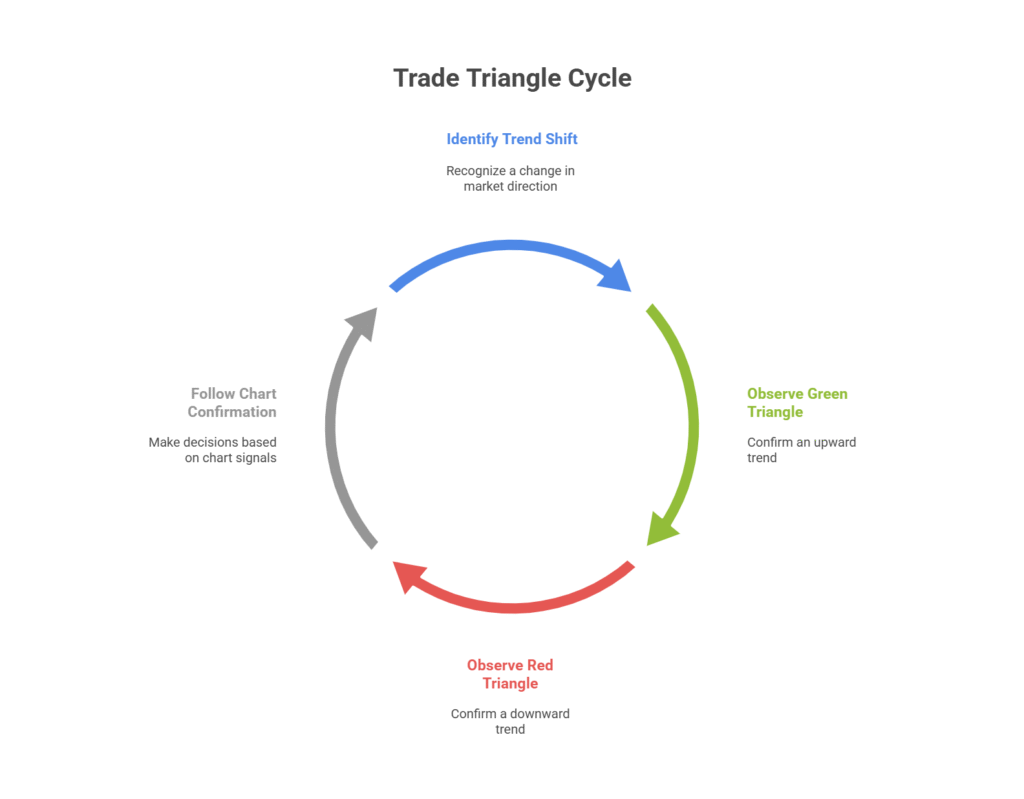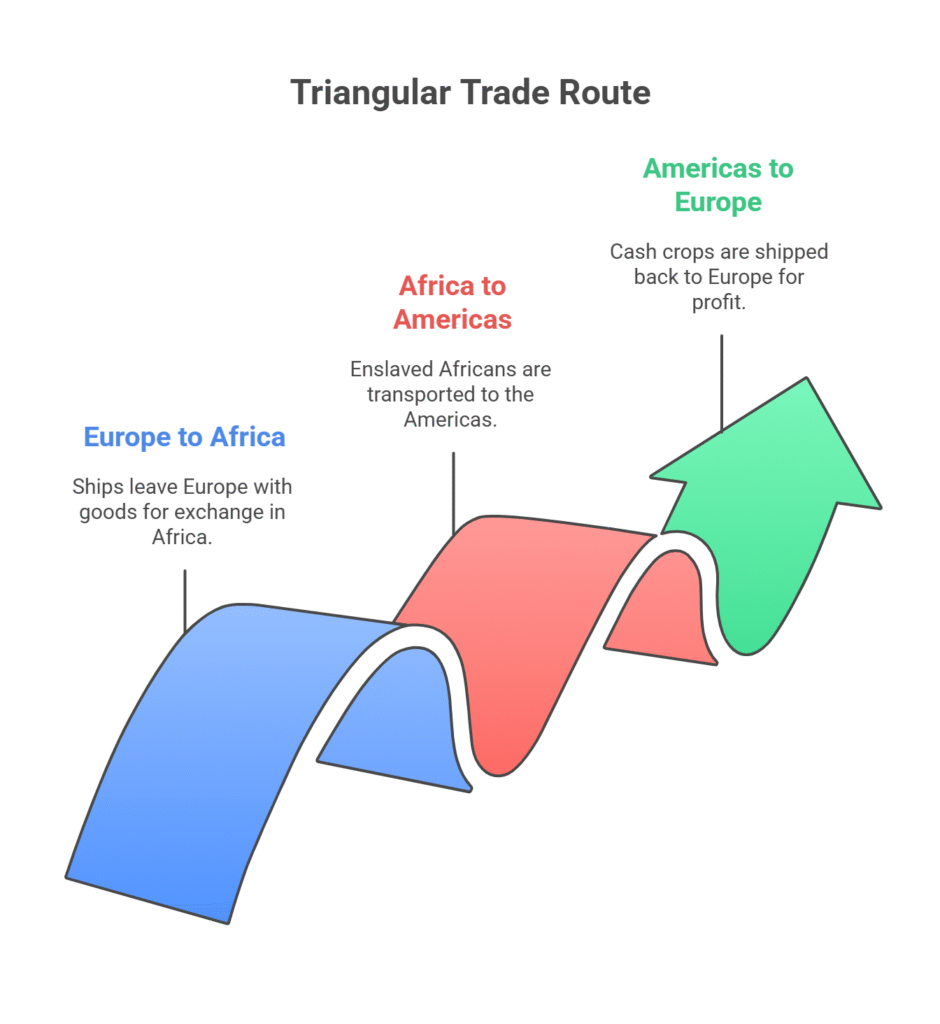Every trader requires clear confirmation of trend direction. Precision guides entry, exit, and risk. But most tools blur signals or rush decisions. Confusion follows.
Therefore, it is often suggested to opt for the Trade Triangle method. It filters noise, confirms trend maturity, and aligns signals across timeframes.
Let’s discuss how it works, what powers it, and why it continues to influence trading decisions worldwide.
While understanding Trade Triangles is important, applying that knowledge is where the real growth happens. Create Your Free Forex Trading Account to practice with a free demo account and put your strategy to the test.
What Are The Trade Triangles?
Trade Triangles show you when a market trend shifts. In fact, they help you stop guessing. A green triangle points to an upward trend. A red one signals a downward move. You follow what the chart confirms—not just what you feel.

According to MarketClub’s official guide on Trade Triangles, the signals come from a custom algorithm. It tracks over 230,000 financial symbols. It includes stocks, forex pairs, cryptocurrencies, ETFs, and more. Each triangle fits a specific timeframe. Monthly triangles show the long-term direction. Weekly triangles guide your overall position. Daily triangles help you choose exact entries and exits. So, what’s your focus—bigger trends or short-term setups?
The algorithm checks real trading data. It considers price movement, percentage changes, highs, and lows. Moreover, it waits for the trend to show real strength before triggering a signal. So, it means you avoid weak starts and late exits. Trade Triangles don’t aim to catch tops or bottoms. They capture the heart of the trend—where most profits lie. That’s why they’re ideal for swing traders and trend followers alike. In fact, they share logic with breakout trade triangle, since both methods confirm moves when price escapes consolidation zones.
Now, what happens when the market drifts sideways? The triangle still appears. But not every signal is actionable. MarketClub advises you to use a filtering system. Their “Trend Analysis Score” gives you that extra layer of confirmation.
Have you ever jumped in too early on a flat chart? That score helps you stay out of trouble. Each signal stays on the chart. You can review them anytime. In fact, they are ideal for backtesting your strategy. You see how your setups perform with real-world signals.
But remember—green does not mean “go” by default. So, look at the price structure. Check key levels. Combine the triangle with your method and use it to confirm, not control.
How The Triangular Trade Worked?
The Triangular Trade worked as a continuous transatlantic system. European powers organized a three-part exchange to move goods, labor, and profit across regions. Each part supported the next. The route formed a triangle connecting Europe, West Africa, and the Americas. In fact, merchants in Europe shipped manufactured goods to West Africa. African rulers and traders exchanged those goods for enslaved people. Captives were then loaded onto ships bound for the Americas.
Now in the second phase, traders transported enslaved Africans across the Atlantic. The voyage, called the Middle Passage, created massive profits. Ship owners sold enslaved people to plantation owners.
As a result, cash crops like sugar, rum, cotton, and tobacco flooded ports in return. Ships loaded with those goods sailed back to Europe. Traders sold the cargo in British, Dutch, and French markets. The profits funded more voyages and expanded colonial economies. So, the trade worked because each region had something the other wanted:
- Europe supplied guns, textiles, tools, and alcohol
- Africa supplied enslaved labor
- The Americas supplied crops grown on plantations
Moreover, no part of the triangle stood alone. The exchange-linked economies built wealth and fueled European dominance. Do you see how one leg of the triangle enabled the next? That’s why the Triangular Trade remained active for over three centuries.
Ready to Elevate Your Trading?
You have the information. Now, get the platform. Join thousands of successful traders who use Volity for its powerful tools, fast execution, and dedicated support.
Create Your Account in Under 3 MinutesTriangular Trade Stages
The Triangular Trade followed a three-stage route across the Atlantic. Each stage served a clear economic role. The system moved goods, people, and crops between Europe, Africa, and the Americas.

Stage 1: Europe to Africa
Ships left Europe with cargo meant for exchange in West Africa. Goods included cloth, firearms, metal tools, beads, and alcohol
- Traders exchanged these for enslaved Africans at coastal ports
- African suppliers delivered captives from inland regions
Stage 2: Africa to the Americas (Middle Passage)
Ships carried enslaved Africans across the Atlantic to plantations. People were confined below deck in overcrowded conditions
- Many died during the voyage from disease or exhaustion
- Survivors were sold in markets across the Caribbean, Brazil, and North America
Stage 3: Americas to Europe
After selling enslaved people, merchants loaded the ship with cash crops. Cargo included sugar, tobacco, rum, cotton, and coffee
- Ships returned to Europe to sell the goods at profit
- Profits funded the next outbound journey
The cycle ran continuously. Goods were moved to Africa. Labor moved to the Americas. Wealth returned to Europe.
What Economic Powers Did It Create?
The Triangular Trade gave Europe an edge it had never held before. Britain, France, Portugal, and the Netherlands used the trade system to generate massive capital. Each voyage turned cheap goods into immense profit. According to BBC Bitesize, a single enslaved person could be exchanged for goods worth just £3 in Africa and then sold for £20 in the West Indies. Its margin built entire industries.
In fact, the profits reshaped Europe’s coastal economies. Cities like Liverpool, Bristol, and Nantes expanded their docks, banks, and factories. Insurance firms and shipbuilders gained new demand. According to Study.com, Britain used the wealth to fund colonial expansion, build naval power, and dominate transatlantic commerce.
Moreover, the plantations in the Americas produced commodities Europe craved. Sugar, rum, and cotton fueled industrial production. The supply of raw goods pushed factory growth, while returns from slave labor financed political power. The Triangular Trade did more than move cargo. It redistributed global power. Europe became richer, more connected, and more industrialized—at the expense of millions. The system didn’t just support empires. It built them.
Economic Triangle to Reshape Regional Trade
A new regional trade order is emerging across Asia. The formation of an economic triangle between Pakistan, Turkiye, and China creates a strong overland network connecting key markets. So, this structure combines the Islamabad–Tehran–Istanbul transport corridor with China’s Belt and Road Initiative (BRI).
As reported by The Express Tribune, the corridor already supports commercial cargo movement. Pakistani trucks carry goods between Turkey and China through land routes. This direct flow improves delivery speed, reduces costs, and increases cross-border efficiency. Trade relations between Pakistan and Turkey have grown stronger. Turkish investment in Pakistan has passed $1 billion, covering sectors such as defense, education, healthcare, and technology. The corridor now supports this investment by making trade more accessible and predictable.
China’s role adds long-term depth. Through the China–Pakistan Economic Corridor (CPEC), Chinese exporters can move goods overland to European gateways. In return, Turkiye can route exports eastward into Chinese markets through Pakistan. The triangle repositions Pakistan as a central trade link. Goods move across borders faster. Investors gain regional access. Roads carry more than cargo—they carry strategic value.
Why Does The Trade Triangle Still Matter Today?
Trade triangles continue to shape how economies link across regions. In historical context, triangular systems built global wealth through structured exchanges. Today, new versions of that model still influence trade logic—especially in emerging corridors like the Pakistan–Turkiye–China triangle.
Modern trade triangles matter because they:
- Improve overland connectivity
- Reduce dependency on maritime chokepoints
- Enable multi-directional trade between Asia, Europe, and the Middle East
As economic centers shift eastward, land-based triangles bring faster market access.
For instance, the Islamabad–Tehran–Istanbul route connects Turkey’s exports with China’s industrial zones. Pakistan becomes a vital connector—benefiting from tolls, logistics, and trade volume. Moreover, tripartite agreements encourage broader partnerships. They support energy flows, industrial development, and regional balance. Infrastructure like CPEC and BRI extends the old triangle logic into digital, financial, and strategic domains.
You see lasting relevance in how nations now prioritize land corridors over isolated bilateral deals. The triangle structure creates balance, gives mid-size economies a seat at the table, and fosters stable, multi-point trade frameworks. In effect, the trade triangle evolves, but never disappears. Its form adapts. Its function remains critical.
What Exactly Was The Trade Triangle?
The trade triangle was a structured system of transatlantic exchange. It linked Europe, West Africa, and the Americas. Each region had a defined role in a profitable three-part cycle.
In fact, Europe sent goods such as guns, cloth, and alcohol to West Africa. West African traders supplied enslaved people in return. Ships then carried those captives to the Americas through the Middle Passage.
In the Americas, plantations used enslaved labor to produce sugar, tobacco, cotton, and rum. So, those goods returned to Europe, completing the triangle. The model drove colonial growth. It supported European empires, expanded Atlantic commerce, and shaped global trade flows that influenced modern systems.
Turn Knowledge into Profit
You've done the reading, now it's time to act. The best way to learn is by doing. Open a free, no-risk demo account and practice your strategy with virtual funds today.
Open a Free Demo AccountConclusion
Trade triangles shape trade history and guide market behavior. They map how goods, influence, and decisions move across regions. Each triangle shows a system—economic, strategic, or algorithmic. It creates momentum through structured exchange. The historical triangle powered colonial empires. The regional economic triangle connects modern partners like Pakistan, Turkey, and China. The MarketClub trade triangles signal trends to traders worldwide. Each reflects how connections form an advantage.
So, you look closely at trade triangles when tracking growth, forecasting shifts, or planning strategy. They explain the flow of power behind trade, not just what moves, but why it matters. Start observing trade through this lens to act with precision and foresight.






